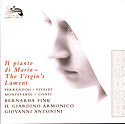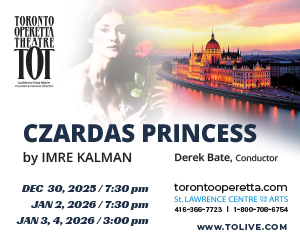 Il pianto di Maria - The Virgin's Lament
Il pianto di Maria - The Virgin's Lament
Bernarda Fink; Il Giardino Armonico; Giovanni Antonini
Editions de l'Oiseau-Lyre 478 1466
Bernarda Fink is a singer of extraordinary measure and a brilliant match for two rare settings of the Virgin Mary's lament: one originally attributed to Handel, but later discovered to be by Giovanni Battista Ferrandini, a composer in the court at Munich; the other by Monteverdi who took the music from his famous Lamento d'Arianna and inserted a sacred text. Rather than matching the impulsive fire of Il Giardino Armonico, Fink holds steady her natural grace and maturity, allowing the orchestra to express the undercurrents of torment and anger while she declares her sorrow with dignified acceptance. The effect is not diminished in any way, in fact, by maintaining her poise she resists all temptation to resort to showy hysterics; but at the same time there is an edge to her delivery that clearly informs us of the depth of her grief. Il Giardino Armonico performs with all the passion and vigour for which they are known, making for an exciting performance that keeps listeners on the edge of their seats during instrumental works by Vivaldi, Marini and Pisandel. In a world premiere recording of Francesco Bartolomeo Conti's Il martirio di San Lorenzo, Fink and the ensemble join together for a deeply moving aria that features a rarely-heard ancestor of the modern clarinet, the soprano chalumeau, which adds a most tender and plaintive note.
Dianne Wells
 Verdi - Messa da Requiem
Verdi - Messa da Requiem
Fantini; Smirnova; Meli; Siwek; Coro del Maggio Musicale Fiorentino; Symphonica Toscanini; Lorin Maazel
Medici arts 2072438
In 2007 for the commemoration of the 50th anniversary of Toscanini's death Lorin Maazel, his erstwhile protégé, gave a series of concerts in Italy. The former child prodigy who at the age of 11 conducted Toscanini's own NBC Symphony and was blessed by the ‘gran Maestro' with a kiss on the forehead is now in his 70s and is himself a gran maestro and one of the foremost conductors of the latter half of the 20th century.
The highlight of these concerts was this memorable performance, captured on DVD, of Verdi's Requiem from the San Marco Basilica where it was first performed in 1874 under the baton of the composer. Under the golden domes, half domes and pendentives of the 1500 year old Byzantine masterpiece was gathered Maazel's own orchestra that he organized for this occasion, with a magnificent choir and soloists of the highest order. Maazel is like a wise owl with hooded eyes, almost immobile, but with the merest flicker of his finger he unleashes these forces into a tremendous whirlwind of sound while another slight flicker silences it in a split second. Without much visible effort he achieves a beautifully detailed, heartfelt, thoroughly understood and perfectly paced performance.
The quartet of soloists, upon which many a performance has crumbled, is a tremendous asset here. Norma Fantini is a highly accomplished soprano with a wide range and great emotional involvement in the final Libera me section. Young Russian mezzo Anna Smirnova is very impressive in her lower registers and her heartfelt solos and Francesco Meli is a strong tenor who shines in the Offertorium prayers. Rafal Siwek, a stentorian basso-profundo, has a perfect voice for Mors stupebit and Confutatis, some of the most impressive moments in the performance.
Janos Gardonyi
 Janáček - The Cunning Little Vixen
Janáček - The Cunning Little Vixen
Tsallagova; Rasilainen; Lagrange; Minutillo; Kuebler; Bracht; Gay; Opera National de Paris; Dennis Russell Davies
Medici arts 3078388
A mere 30 years ago Leos Janáček's operas were virtually unknown in the West, but today there is hardly a reputable opera company that hasn't performed some of them. The Canadian Opera Company, for one, can be proud of having performed five of the operas here in Toronto. Although Paris is just beginning to discover his greatness, this live performance certainly makes up for any lack of appreciation in the past. Apart from an interesting, novel concept, there is abundant talent and wit in the stage direction, sets, colour and costume design, not to mention singers and musical direction.
According to director André Engel, the stage is set as a bright sunflower field, representing nature, but bisected by a railway that shows mankind's brutality. Where the two meet is where things are happening, where indeed anything can happen. There is tragedy, but in Janáček's optimistic outlook it is followed by rebirth and the cycle of nature continues indefinitely.
One of Janáček's most beautiful scores, the story was undoubtedly inspired by his love for a much younger woman at the age of 70. The opera simply throbs with love and affection towards his young female protagonist, the vixen, in this case the ebullient Russian high soprano Elena Tsailagova, who simply radiates and dominates the performance. The three rather pathetic male figures are all well characterized and sung by Jukka Rasilainen (forester), David Kubler (schoolmaster) and Roland Bracht (parson). There is also a charming choir of children dressed in hilarious costumes representing the little animals.
Music Director Dennis Russell Davies' flawless and beautifully flowing conducting brings out the beauty and lyricism of the score and deserves much of the credit for this delightful performance.
Janos Gardonyi



